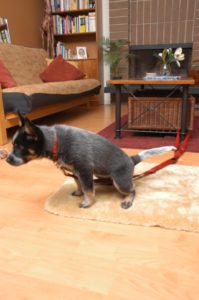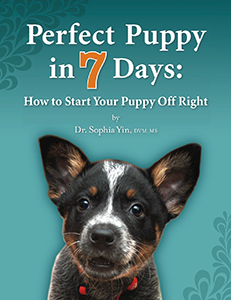OK. By now, most of you know the potty training basic plan such as the one found here in the April 2009 post “A Foolproof Plan for Potty Training Puppies“. Take the puppy out first thing in the morning and stand around until she does #1 and #2. Then praise her when she does, give her a treat and some play time and water. Then, throughout the day either have her tethered to you or on leash nearby or in her crate where she’s not likely to potty. Or keep an eagle eye on her so you can take her out at the first sign she has to potty. That sign may be: she’s just eaten, or drunk water, or woken up from a nap, or is now sniffing around. Interrupt accidents and rush the pup to a proper potty place but don’t punish her or scare her or she may just learn to sneak off and potty behind your back. And of course clean all accidents up promptly with an enzymatic cleaner.
Every day, thousands of people hear this advice and try to follow it only to be frustrated. The issue boils down to several factors, which can be addressed with a few tips.
Puppy potty-training Tip 1: Some dogs are potty geniuses. Others aren’t. Some dogs learn virtually by magic. You take them out frequently for a few days and all of a sudden they’re potty trained. In fact my parents’ last four dogs were like that. Meaning, if you’re sort of consistent, the pooch will learn. But in other cases, the dogs seem to be potty training dunces. Realistically, in the wild, feral dogs may keep their immediate sleeping area clean, but areas close by are “in bounds.” So it’s not that odd that your dog thinks his actual bed should not be a potty spot but the rug right next to it is OK. In these cases, potty training is really just about forming a habit-never giving Rover the opportunity to go in the wrong place. Only give him opportunities to potty in the right places.
Puppy potty-training Tip 2: Some puppies will potty even when tethered close to you. For some puppies, tethering them close to you won’t prevent them from pottying. It will only give you a better chance to keep an eye on them. And some puppies can potty in the blink of an eye. For these puppies you’ll have to rely on keeping them crated in a small den-like crate and then bring them out for potty sessions where you make sure they potty before they are allowed to play. If they don’t potty quickly, they go back in their crate for 15 minutes before their next potty opportunity. They must learn to potty automatically when you take them outside and then never get the opportunity to have an accident when you’re inside. Once they potty, they can play, but if they’ve eaten or drunk water, you’ll have to bring them outside again after another 10–15 minutes before they go back into their crate. In fact you may be having 15-minute play sessions in the house every few hours and then long play session outside since, otherwise, when they’re in the house they are resting in a crate.
Puppy Potty-training Tip 3: Realize that young puppies have frequently potty urges. Young puppies can potty a lot! Especially if they’re only 7–9 weeks old. They can drink water and then seemingly 5 minutes later pee it all out. So just because they pottied outside 5–10 minutes ago doesn’t meant they won’t do it inside as soon as you look the other way. If you find that you have this problem of pups pottying even shortly after they’ve pottied outside, instead of saying “But they just pottied outside” or ” I just let them play unsupervised for a minute,” get a clue! Expect them to potty even right after they’ve gone outside and whenever you leave them unsupervised and change your behavior accordingly. That is, be ready to crate them or keep your eye on them at all times.
Puppy Potty-training Tip 4: Some puppies need to learn to hold their #1 urge a little bit. Some puppies need to learn to hold their pottying. I’m talking primarily about pee. These pups seem to just potty whenever they get a slight urge as if pottying is a pastime. These puppies need to be crated for longer periods for at least several days. In general, during the day they can be crated the same amount of time as their age in months. So an 8-week old puppy can be crated for about 2 hours and a 12 week old can be crate for around 3 hours during the day. Once your vet has assured you that the frequent piddling is not due to a urinary tract infection, start crating the puppy for longer hours. For instance, start crating the 12 week old for 2–3 hours at a time so she learns to hold it. When you take her out, reward her with long play sessions so she gets enough interaction, play, and training time too. But when finished, put her back in the potty-safe crate area.
Get the idea? For some dogs, you can’t cut any corners. You can’t let them wander out of sight for 2 seconds or expect that they will hold it if they’ve just gone potty outside and had a drink of water. For these dogs, you can try a doggie diaper. Maybe they won’t potty in that. Or you can try an indoor potty system where you place them in an exercise pen with a sleeping area and a fake grass potty system or pee pad potty area and no other type of surface. They can learn that the different substrates are for different purposes. But chances are you’ll have to just get realistic and alternate between strict crating, safe potty times outside, and eagle-eye supervision when they are getting their playtime. That means you’ll have to make a special effort to be sure they get enough playtime too which adds even more planning to your puppy care. But that’s the joy and pain of having a puppy. And the reward of having the house as a potty free zone is priceless. For more information, checkout “Perfect Puppy” products. Chapter 4 of the book Perfect Puppy in 7 days covers this and more.




